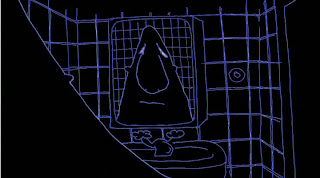El diario de Leonardo / Leonardo's diary
Sin diálogos/No dialogue
Una reflexión poética sobre la vida humana, la juventud y la vejez, inspirada en motivos y esquemas de Leonardo Da Vinci, unidos a otro tipo de dibujos igualmente animados y escenas cotidianas de la vida checa sacadas de contexto.
Film nominado a la Palma de Oro al Mejor Cortometraje en el Festival de Cannes 1972.
El director checo una vez más ha seguido buscando y experimentando dentro del mundo de la animación, en su cine siempre se encuentra algo original y diferente a lo hecho hasta ahora.
A diferencia de los cortos de Disney en donde se hacían las historias y más tarde se añadía la música según lo realizado, con Svankmajer es diferente.
Ya realizado en otros cortos, la animación va al compás de la música, el montaje y el ritmo de las figuras se mueven al compás musical, en Svankmajer la música es igual o quizás más importante que la animación.
En este caso el montaje es peculiar, se combinan los dibujos de Leonardo en movimiento y mientras tanto se intercalan escenas de personas, escenas de guerra, fiestas, bailes populares, pero sobre todo, guerra.
Las escenas pasan a gran velocidad y muchas veces pasan desapercibidas, por eso es necesario una segunda visión del corto para poder entender el mensaje, o los mensajes que se quieren trasmitir.
Te guste o te disguste, es Svankamajer y en este caso un Svankmajer muy experimental pues para nada es su estilo, no es la manera con la que mejor suele hablar pero independientemente, lo hace muy bien.


Leonardo's Diary is a dazzling formal experiment from Czech animator Jan Svankmajer, in which he uses the sketchbook drawings of Leonardo as a starting point for a series of fluid animations in which the penciled images leap into motion. It's a test of mastery for Svankmajer, who uses the grace and detail of Leonardo's perfectly rendered faces and architectural constructs as a base for some remarkable animations: a fierce fight between soldiers on horseback, a woman demurely turning away from the camera and shielding her eyes, a man's eye turning around in its socket to reveal its insides and lead the way inside the body. The film is based on the fluidity between various states of being. Leonardo's figure drawings, with their advanced understanding of anatomy and sensitivity to the movement of muscles, lead naturally into the drawings of the internal workings of the body, muscle and then bone peeled back to reveal the pulsating organs within. Outside leads to inside and then back again. Likewise, the figures are morphed into buildings, the contours of a woman's face gradually transformed into the rigid lines of architecture, and elsewhere the human form is broken up into mathematical abstractions, a woman's hair curling out into a series of circles and geometric figures arrayed around her face.
This fluidity of concepts and states of being is extended by Svankmajer into the structure of the film, which alternates these pencil animations with found black and white footage of various ordinary people and events. There is a hint of political subtext here, in the form of images that seem to be taken from protests of some kind: youths throwing rocks and yelling, mounted police scattering and attacking crowds of protesters. Most of the images, though, correspond to Leonardo's art in more humorous ways. Svankmajer frequently selects absurd and ridiculous fragments of footage to comment on Leonardo's seeming exaggerations. The point seems to be that Leonardo's grotesque, caricatured people and wild ideas aren't necessarily so wild after all. Just as his fanciful sketches of flying machines predicted modern-day bomber planes, his craggy-faced people have tangible foundations in ordinary people.
Leonardo's Diary is a fascinating experiment in motion, a study in how drawings can suggest and capture the movement of the human form. Leonardo's drawings already contain the elements of motion, the tensed muscles and expressive facial features that seem to have been captured in the middle of a movement. Svankmajer's animation only restores these drawings to their natural life, extending the sweep or an arm or the deep scowl of a heavily lined face into a moving body completing the motion that Leonardo arrested by drawing it. The film is therefore a mediation between multiple states of reality, from the static image trapped on the page to the animated form restored to motion to the actual images of reality and life itself. This is a continuum flowing from reality to art and from art to reality. The art comments on and reflects the reality, in a dialogue between Svankmajer, Leonardo, and the world at large.
DVDRip por HawkmenBlues
Link:
https://rapidshare.com/files/2840303444/Diario.1972.www.nplus2.org.mkv
























































